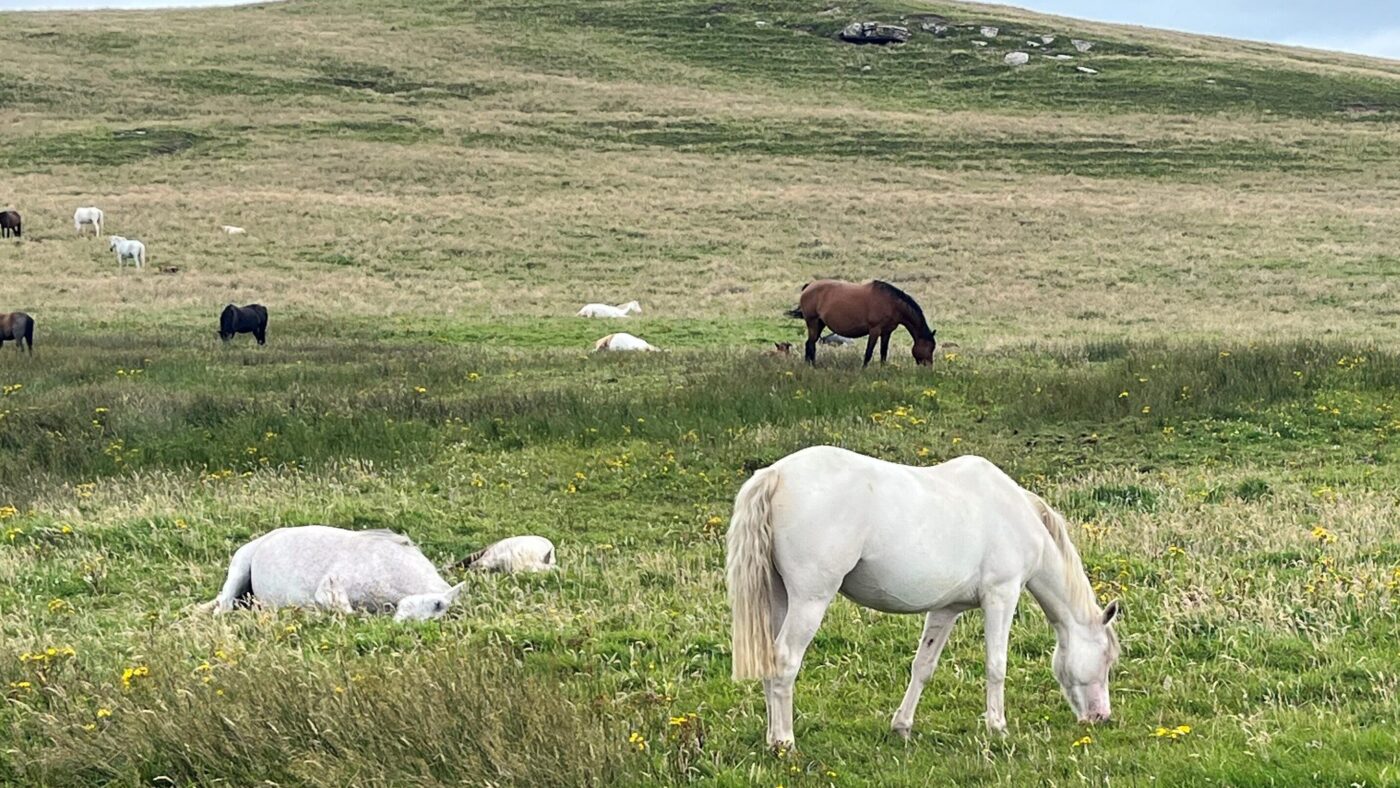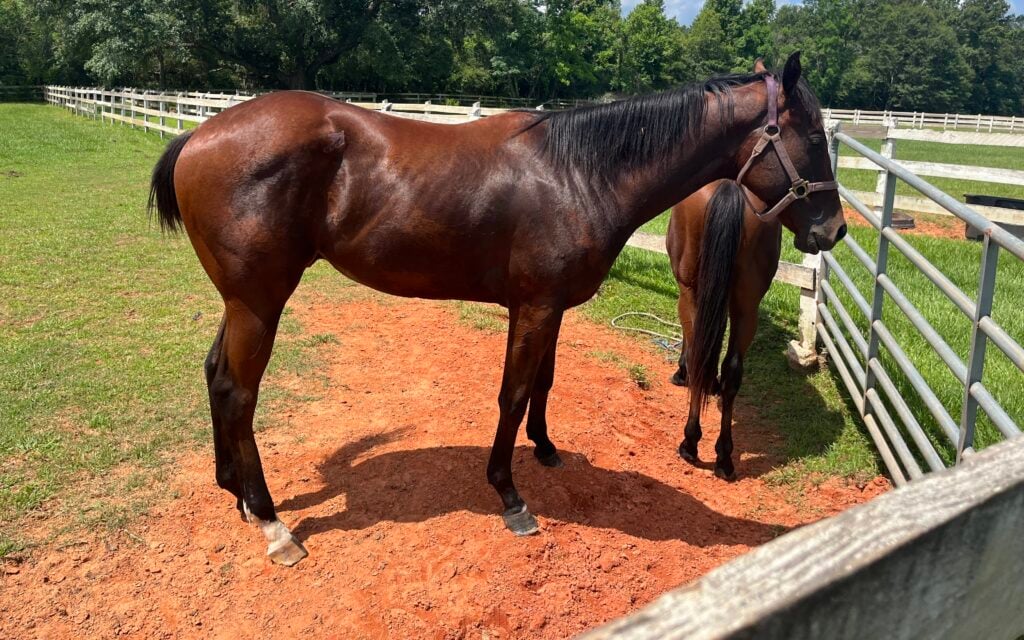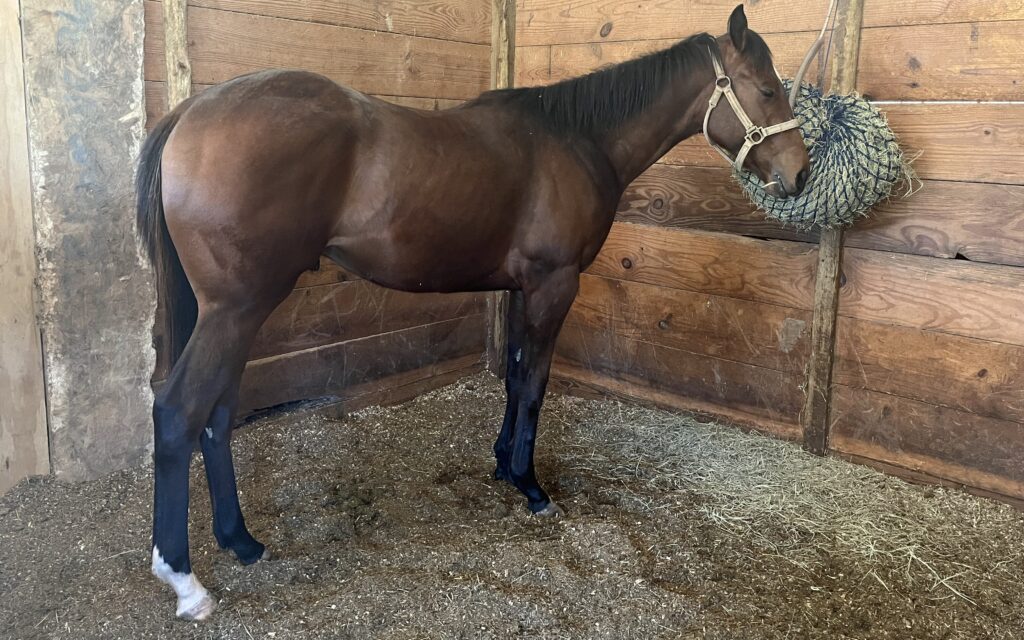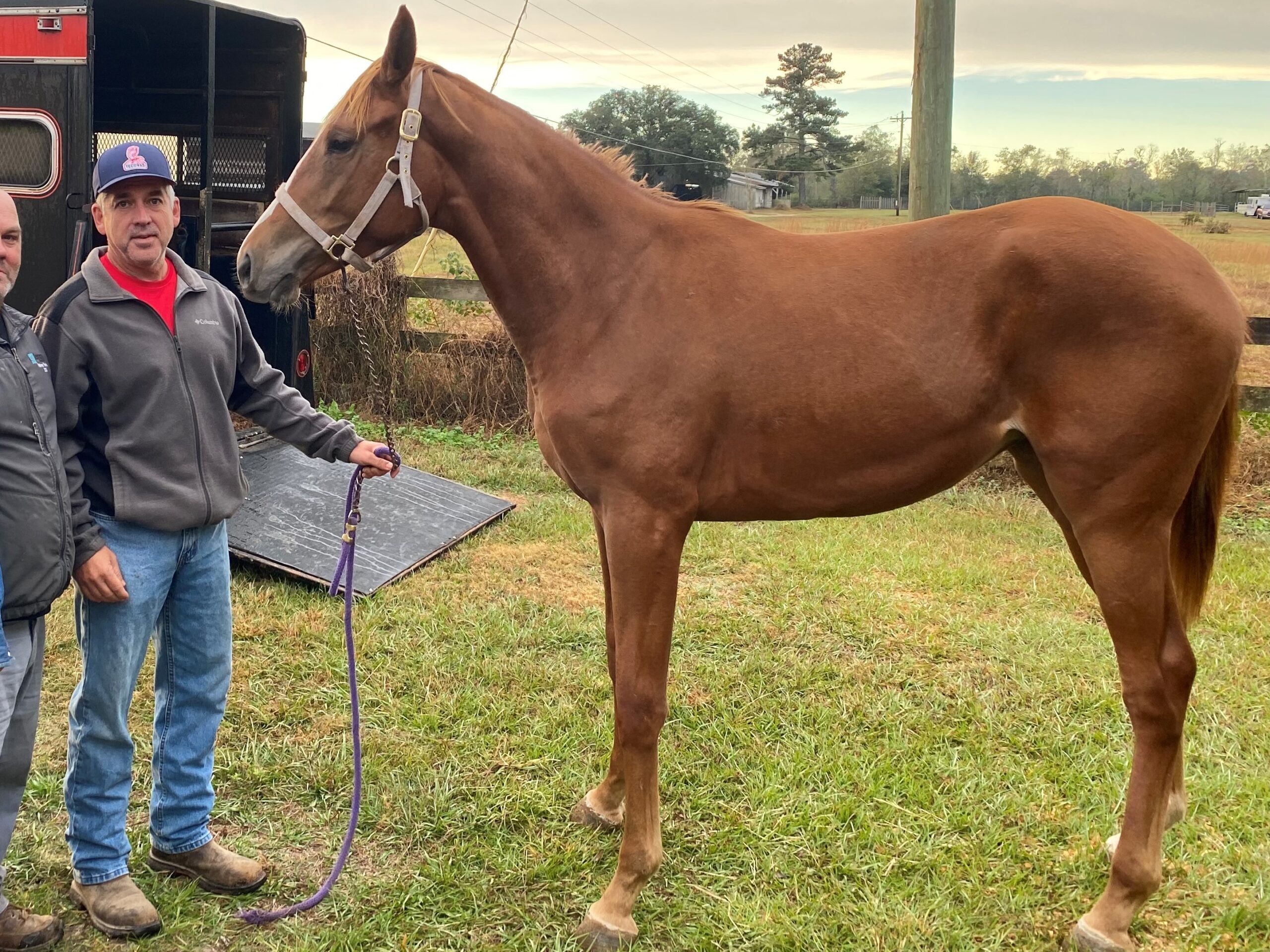Last updated: January 11, 2025
Why do horses sleep standing? This seemingly mysterious ability isn’t just a quirky habit—it’s a survival strategy deeply rooted in evolution. Horses, unlike many large animals, have developed the unique ability to sleep both standing up and lying down, allowing them to rest while staying alert to danger.
With over 25 years of experience as a racehorse owner and trainer, I’ve seen firsthand how essential proper rest is for a horse’s health and performance. Understanding why horses sleep standing can help you better care for your horse, including ensuring they get enough deep REM sleep for optimal health and recovery.
Let’s first delve into the incredible anatomy that makes this possible—the stay apparatus.

How the Stay Apparatus Supports Standing Sleep in Horses
To understand how horses can rest while standing, it’s essential to explore the unique anatomical system that makes this possible: the stay apparatus.
Standing Doze: Light Sleep on Their Feet
Horses engage in a light sleep phase called standing doze, where they stay partially alert. This allows them to rest without fully surrendering to vulnerability—a crucial advantage for prey animals like horses, enabling them to react quickly to potential threats. I’ve often noticed my own horses resting this way, especially when in unfamiliar environments, staying relaxed yet ready to move.
The Stay Apparatus: Nature’s Locking System
The stay apparatus is a sophisticated system of tendons and ligaments that locks a horse’s leg joints, allowing them to rest while standing with minimal muscle effort,(Source: The Equine Institute).
Expanded Details on the Stay Apparatus
The stay apparatus works through a sophisticated locking system:
- In the hind legs, the patella (kneecap) hooks over a ridge on the femur (thigh bone), allowing the leg to stay in place without continuous muscle use.
- In the front legs, the suspensory ligament and check ligaments prevent the legs from buckling.
This system allows horses to rest safely without risking collapse, conserving energy while maintaining balance. I’ve observed how my horses shift their weight from one hind leg to another, a subtle sign of the stay apparatus in action.
Visual Demonstration For a clearer understanding, watch this educational video from Michigan State University’s Veterinary School that demonstrates the stay apparatus in a horse. Warning: This video features a veterinary instructor using a horse cadaver to explain the stay apparatus. While highly informative, it contains graphic content and may not be suitable for sensitive viewers.

Understanding Equine Sleep Cycles: From Drowsiness to REM Sleep
Horses experience four distinct stages of sleep:
- Wakefulness: Fully alert and aware of their surroundings.
- Drowsiness: A light sleep phase, typically while standing, where the horse remains partially alert.
- Slow-Wave Sleep (SWS): A deeper, restorative sleep phase that can occur while standing or lying down, helping with physical recovery.
- REM Sleep: The deepest sleep stage, essential for mental restoration, memory, and learning. Horses must lie down to enter REM sleep due to the need for full muscle relaxation.
The Importance of REM Sleep
Prolonged REM sleep deprivation can lead to fatigue, behavioral issues, stumbling, and a higher risk of injury, as shown in research by Bertone (2006). Horses need about 2–3 hours of REM sleep daily in short bursts to maintain mental and physical health (National Institute of Health).

Sleep Duration and Adaptability
Unlike humans, horses don’t sleep for long, continuous periods. They take short naps throughout the day and night. Horses in secure, familiar environments are more likely to lie down and achieve deep REM sleep. In contrast, horses in unfamiliar or stressful surroundings may avoid lying down, risking sleep deprivation.
Tip for Owners:
Provide soft, clean bedding and a quiet, safe space to encourage your horse to lie down for essential REM sleep.
Comparison with Other Animals
Unlike predators like lions that can afford long sleep periods, horses have evolved fragmented sleep patterns to stay vigilant. This need for alertness is shared with other prey animals, such as deer and antelope, who also nap lightly and rely on herd dynamics for safety.
The Evolutionary Advantage: How Standing Sleep Keeps Horses Safe
The ability of horses to sleep while standing is a vital survival strategy shaped by millions of years of evolution. In the wild, horses rest in shifts, with some standing guard while others sleep—a behavior well-documented in the U.S. Department of the Interior’s (2009) ethogram study. This constant vigilance helps protect the herd from predators.

Standing sleep allows horses to stay alert and quickly escape danger. I’ve seen this instinct in my own horses—when transported to new tracks, they often hesitate to lie down, remaining on their feet until they feel secure. Providing a quiet, familiar environment helps them relax and get the deep, restorative REM sleep they need.
Other prey animals, like deer and zebras, also rely on fragmented sleep and herd vigilance, showing how effective this survival mechanism is across species.
Tip for Owners: Create a calm, stress-free space with soft bedding to encourage your horse to lie down and rest fully.

Impact of Sleep on Horse Health and Performance
While standing sleep offers horses significant physical advantages, understanding its full impact on health and performance is essential for proper care.
Musculoskeletal Health Benefits
Standing sleep reduces prolonged pressure on muscles and joints, preventing stiffness and circulation issues that can occur when lying down for extended periods. This position also helps prevent pressure sores and edema. Research by Schumann et al. (2003) explains how the equine hind limb is actively stabilized during standing, supporting this energy-efficient resting behavior.
The Critical Role of REM Sleep
Horses need 2–3 hours of REM (Rapid Eye Movement) sleep daily for muscle recovery, memory processing, and emotional stability. This deep sleep phase can only occur when horses lie down due to the need for full muscle relaxation. Research by Greening et al. (2021) highlights that disruptions—such as frequent travel, hard bedding, and loud or unstable environments—can reduce REM sleep, leading to stress, irritability, and physical fatigue.
Supporting this, Bertone (2006) documented cases where severe sleep deprivation caused excessive drowsiness and dangerous physical instability in horses. Additionally, the Journal of Equine Veterinary Science (2019) found that auditory disturbances in stables can disrupt nocturnal sleep, increasing the risk of sleep deprivation.
In my own barn, I’ve seen how maintaining a quiet and consistent environment improves my horses’ rest and performance. We use fans for white noise, limit loud noises during rest periods, and provide soft, clean bedding. These simple adjustments noticeably improve focus and energy during training.

Impact on Performance
For performance and racehorses, quality rest—including REM sleep—is vital for muscle recovery, mental sharpness, and coordination. Sleep deprivation can lead to reduced stamina, poor performance, and slower reaction times. A review by Greening et al. (2022) confirms that poor sleep quality can negatively impact both physical health and mental performance in horses.
I witnessed this firsthand with one of my fillies who struggled in races after frequent travel disrupted her rest. Adjusting her routine to prioritize consistent rest led to noticeable improvements in her stamina and focus, reinforcing how essential proper rest is for racehorses.
Common Equine Sleep Disorders and How to Spot Them
Horses can develop sleep disorders, including:
- Narcolepsy: A neurological disorder causing sudden muscle weakness or collapse, often triggered by excitement or stress. A case involving a Thoroughbred with sleep attacks and sleep terrors is documented by Ahern (2018).
- Hypersomnia: Excessive, non-restorative sleep that leads to sluggishness and poor performance.
If you suspect your horse has a sleep disorder, consult a veterinarian for diagnosis and treatment, as advised by the American Association of Equine Practitioners (AAEP).

FAQs About How Horses Sleep and Rest
Do horses really sleep standing up?
Yes, thanks to the stay apparatus—a system of tendons and ligaments that locks their leg joints, allowing them to rest while standing without collapsing.
Why do horses sleep standing up?
Horses sleep standing up as a survival instinct to stay alert for predators. However, they must lie down to achieve deep REM sleep for full mental and physical recovery.
How do horses sleep standing without falling over?
The stay apparatus locks their knees and stabilizes joints. In the hind legs, the patella hooks over the femur, while front-leg ligaments prevent buckling.
Do horses lie down to sleep at all?
Yes, horses must lie down to enter REM sleep, which is critical for muscle recovery and mental health. While they often doze standing, they need about 2–3 hours of REM sleep daily, achieved only when lying down.
What happens if a horse doesn’t get enough REM sleep?
Lack of REM sleep can cause fatigue, irritability, stumbling, and increased injury risk. Chronic sleep deprivation may lead to dangerous collapses.

Conclusion
The phenomenon of horses sleeping while standing up is a testament to their remarkable adaptation and survival strategies. We’ve explored the key aspects of this behavior, shedding light on why horses doze in a standing position and the vital role it plays in their well-being.
As prey animals, horses have evolved this unique ability over centuries to stay alert and respond swiftly to potential threats, ensuring their safety in the wild. Understanding this behavior is not only intriguing but also essential for horse care and welfare.
It reminds us of the intricate balance between nature and nurture in our equine companions. By providing them with environments that allow for both standing and lying sleep, we contribute to their physical and mental health, ensuring they lead comfortable and stress-free lives.
Have you observed how your horse sleeps? Share your experiences in the comments, and check out our Horse Care Checklist for more tips on improving your horse’s well-being.
Quiz: Busting Horse Sleep Myths (Answers below)
Here’s a table that summarizes key aspects of horse sleep patterns:
| Aspect | Description |
|---|---|
| Sleeping Position | Horses sleep both standing and lying down. |
| Standing Sleep | Irritability, lethargy, and, in severe cases, collapsing. |
| Lying Down Sleep | Necessary for REM sleep; horses must lie down to achieve deep sleep. |
| Duration of Sleep | Total of about 3 hours per day, including short naps and REM sleep. |
| REM Sleep | Occurs when lying down; essential for cognitive function and overall health. |
| Evolutionary Reason | Standing sleep allows for quick escape from predators, a trait from their prey animal ancestry. |
| Health Implications | Lack of REM sleep can lead to health issues like weakened immunity and behavioral changes. |
| Stable Environment | A comfortable and safe stable is crucial for enabling horses to lie down for REM sleep. |
| Exercise and Diet | Regular exercise and a balanced diet contribute to healthier sleep patterns. |
| Signs of Sleep Deprivation | Irritability, lethargy, and in severe cases, collapsing. |

About the Author: Miles Henry
Lifelong Horseman | Racehorse Owner | Published Author
Miles Henry brings over 25 years of hands-on experience training and owning Thoroughbred racehorses. Raised with Quarter Horses and Appaloosas, he’s spent a lifetime learning from horses—on the track, in the barn, and in the field. Today, he runs a small but successful racing stable in Louisiana and shares real-world insights on HorseRacingSense.com, helping horse owners, fans, and bettors navigate the sport with confidence.
📚 Books: View Miles’s books on Amazon »
🎧 Podcast Guest: Animal Tales Ep. 32 |
YouTube Interview
📩 Newsletter: Sign up for racing tips and horse care advice »
🔗 Follow Miles:
Twitter |
Facebook |
YouTube


